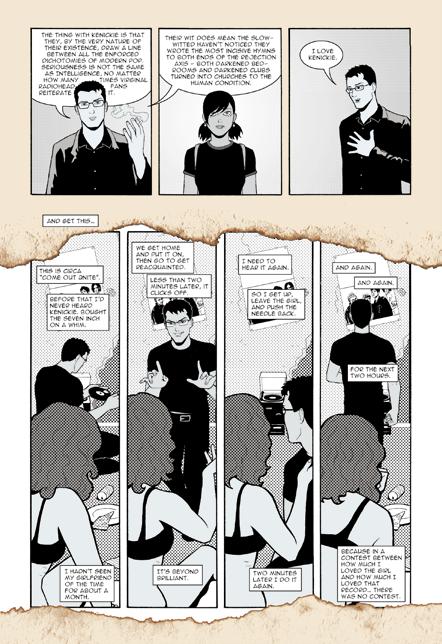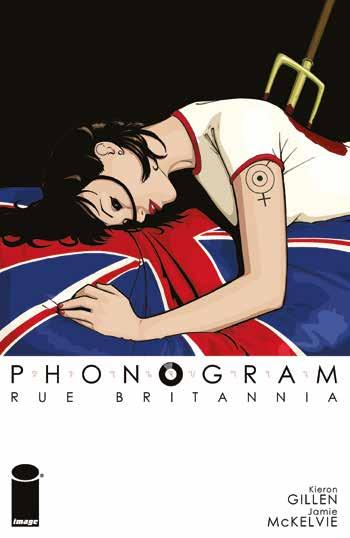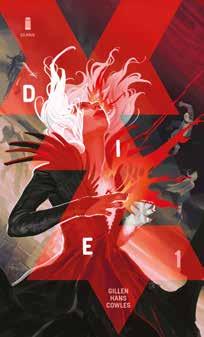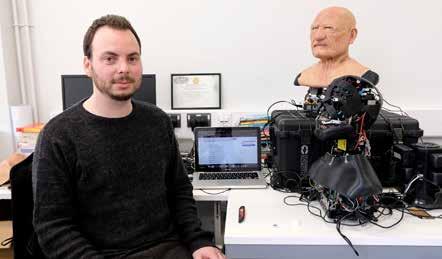
6 minute read
sensitive episodes in world history
Comic Art
comic book hero
Writer Kieron Gillen, a superhero to many in the world of comic books, reveals his inspirations and aspirations – and why he wants to set a story in a Stafford chippy.
Comic Art ieron Gillen was 10 when he wrote his first comic book. It was briefly a hit among his friends, before teachers at his Stafford primary school declared it ‘evil’ and confiscated it. Fast forward 30-odd years and Kieron has had rather more success in the field. He was recently awarded an honorary doctorate by Staffordshire University for his outstanding achievement in cartoon and comic arts and for creating award winning publications – notably Phonogram and The Wicked + The Divine – and working on X-Men, Thor, Iron Man, Young Avengers and Star Wars for Marvel. It all began back at St Austin’s Catholic Primary School, where the enterprising pupil charged his friends around 20p a time to read the Transformers comic he’d written and drawn. Kieron, who grew up in Doxey and Rickerscote, remembers: “I’d made £1.73 before the teachers noticed that one of the robots had an inverted pentagram on its chest. I had no idea what it was, but they considered it evil. They confiscated the comic and gave the money to charity.” Reading the Beano and Dandy was replaced by playing computer games as a teenager. He paid his way through a biology degree at Bath University by writing for Amiga Power, then landed a job as a staff writer for PC Gamer. Comics pulled him back when he discovered Alan Moore’s Watchmen aged 21. “Then at 25, around 2000, I discovered Warren Ellis and his books The Authority, Planetary and Transmetropolitan,” remembers Kieron. “I went from buying one or two comics a year to going into a comic shop every week for the next issue. I had all the passion of a late convert.
“Ellis ran an early comics website. I went on the forum and found people talking about this whole new world, about the American underground scene and Japanese manga. It was really exciting. “Six months later I went to my first comic con in Bristol. I wrote my first comic script that night after coming home, quite late and not entirely sober. It was a story called Hit, a car crash in slow motion. It was formless and five pages but I turned it into a zine.”
For several years Kieron earned a living writing about gaming in the daytime while pursuing his passion for comics in the evening. The roles K

gradually reversed until comics took over. Kieron says: “After Hit I wanted to do something bigger and more connected. That became Phonogram around 2002 when I met Jamie McElvie and persuaded him to draw it. It was my first real comic, though not until we took it to Image in 2006. “I made very little money on Phonogram. The deal was that Jamie got paid first up to a limit, which we didn’t hit for a long time. Issue three made Continued over the page
Kieron’s work in Phonogram

me £500. It sold OK – for a black and white book about Britpop it sold very well – and was critically acclaimed, and without that I wouldn’t have been spotted by Marvel. It was the calling card I needed. “You don’t go into comics to become rich, you go into it because you love the medium. I didn’t start getting decent wages until I started working for Marvel in 2008.
“Earlier that year we went to a comic con in Ireland which went badly. We thought we were invited as guests but they charged us £300 for the table and we sold nothing. I slept on the floor in a friend’s hotel room and remember waking up with dust on my tongue, thinking I’m too old for this!” Phonogram features a mage who uses Britpop

to power his magic – does Kieron have favourite Britpop artists?
“Two bands I will defend unreservedly are Elastica and Pulp, as they are incandescently brilliant. Pulp are so smart and funny and they don’t really make them like Jarvis Cocker.
“Phonogram was very personal and weird and if I only produced one book, I would be happy for it to be that. It’s not perfect but it’s ours.” Kieron and Jamie produced The Wicked + The Divine next, which won Best Comic at the 2014 British Comic Awards and has been translated into 10 languages. It follows teenager Laura as she meets the Pantheon, 12 reincarnated deities masquerading as pop stars.
Kieron described it as “a superhero comic for anyone who loves Bowie as much as Batman”. He also admits that its themes of life and death were sparked by his father’s diagnosis with terminal cancer. The final collection of The Wicked + The Divine was released in October 2019 and marks the end of Kieron and Jamie’s working relationship.
Kieron explains: “Jamie wants to write and draw his own stuff which is understandable. I’m not very good at drawing and lack patience. I describe myself as a parasite, living off the artist’s talent! “I’m now working on Die with Stephanie Hans, who I met at Marvel doing Loki: Journey into Mystery. I call Die ‘Goth Jumanji’. A group of ‘90s kids are sucked into a fantasy game. They get out, mentally scarred, but are dragged back in as adults. “It’s set in Stafford. I want to write a scene at the Windmill chippy, such an iconic part of my teenage years. My family still live there. Mum was so proud when I received my honorary doctorate from Staffordshire University. It was such an incredible honour, especially as I’m the son of a builder and the first kid in my family to go to university.”
Kieron lives in London with his wife Chrissy Williams, a poet and editor of his books.
“Chrissy would define her job as trying to get what I think is on the page out of my head,” explains Kieron. “She can push me harder than anyone else. Though when we started working together, we said let’s not talk about books in the bedroom because otherwise it takes over your whole life.” How does Kieron see the future of comics? “It’s been called a dying medium for 70 years!” he smiles. “It’s still pretty solid and isn’t going away. In 2003 there were one or two comic cons in the UK, now you can go to one every weekend. The success of Marvel films has a lot to do with that.
“Young adult books are huge. Raina Telgemeier’s Smile is the number one selling book, full stop, in America. She’s done a guide on how to write a comic book, so that’s a whole new generation of creators I can’t wait to see.
“Stafford now has a great comic shop, Too Fat Goblinz. There are lots of web comics but print is still big. I hope comics’ future is even bigger than it is at present.”













